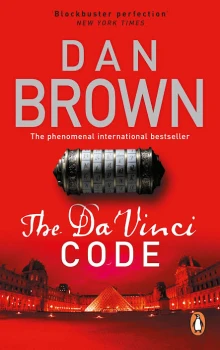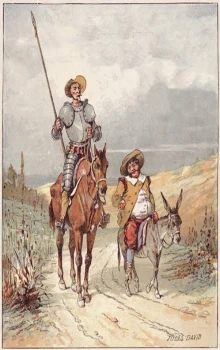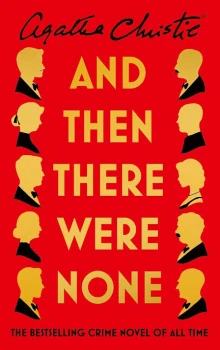Kneeling in the first pew, Silas pretended to pray as he scanned the layout of the
sanctuary. Saint-Sulpice, like most churches, had been built in the shape of a giant
Roman cross. Its long central section—the nave—led directly to the main altar, where it
was transversely intersected by a shorter section, known as the transept. The intersection
of nave and transept occurred directly beneath the main cupola and was considered the
heart of the church . . . her most sacred and mystical point.
Not tonight, Silas thought. Saint-Sulpice hides her secrets elsewhere.
Turning his head to the right, he gazed into the south transept, toward the open area of
floor beyond the end of the pews, to the object his victims had described.
There it is.
Embedded in the gray granite floor, a thin polished strip of brass glistened in the stone
. . . a golden line slanting across the church's floor. The line bore graduated markings,
like a ruler. It was a gnomon, Silas had been told, a pagan astronomical device like a
sundial. Tourists, scientists, historians, and pagans from around the world came to Saint-
Sulpice to gaze upon this famous line.
The Rose Line.
Slowly, Silas let his eyes trace the path of the brass strip as it made its way across the
floor from his right to left, slanting in front of him at an awkward angle, entirely at odds
with the symmetry of the church. Slicing across the main altar itself, the line looked to
Silas like a slash wound across a beautiful face. The strip cleaved the communion rail in
two and then crossed the entire width of the church, finally reaching the corner of the
north transept, where it arrived at the base of a most unexpected structure.
A colossal Egyptian obelisk.
Here, the glistening Rose Line took a ninety-degree vertical turn and continued directly
up the face of the obelisk itself, ascending thirty-three feet to the very tip of the
pyramidical apex, where it finally ceased.
The Rose Line, Silas thought. The brotherhood hid the keystone at the Rose Line.
Earlier tonight, when Silas told the Teacher that the Priory keystone was hidden inside
Saint-Sulpice, the Teacher had sounded doubtful. But when Silas added that the brothers
had all given him a precise location, with relation to a brass line running through Saint-
Sulpice, the Teacher had gasped with revelation. “You speak of the Rose Line!”
The Teacher quickly told Silas of Saint-Sulpice's famed architectural oddity—a strip of
brass that segmented the sanctuary on a perfect north-south axis. It was an ancient
sundial of sorts, a vestige of the pagan temple that had once stood on this very spot. The
sun's rays, shining through the oculus on the south wall, moved farther down the line
every day, indicating the passage of time, from solstice to solstice.
The north-south stripe had been known as the Rose Line. For centuries, the symbol of
the Rose had been associated with maps and guiding souls in the proper direction. The
Compass Rose—drawn on almost every map—indicated North, East, South, and West.
Originally known as the Wind Rose, it denoted the directions of the thirty-two winds,
blowing from the directions of eight major winds, eight half-winds, and sixteen quarter-
winds. When diagrammed inside a circle, these thirty-two points of the compass perfectly
resembled a traditional thirty-two petal rose bloom. To this day, the fundamental
navigational tool was still known as a Compass Rose, its northernmost direction still
marked by an arrowhead . . . or, more commonly, the symbol of the fleur-de-lis.
On a globe, a Rose Line—also called a meridian or longitude—was any imaginary line
drawn from the North Pole to the South Pole. There were, of course, an infinite number
of Rose Lines because every point on the globe could have a longitude drawn through it
connecting north and south poles. The question for early navigators was which of these
lines would be called the Rose Line—the zero longitude—the line from which all other
longitudes on earth would be measured.
Today that line was in Greenwich, England.
But it had not always been.
Long before the establishment of Greenwich as the prime meridian, the zero longitude
of the entire world had passed directly through Paris, and through the Church of Saint-
Sulpice. The brass marker in Saint-Sulpice was a memorial to the world's first prime
meridian, and although Greenwich had stripped Paris of the honor in 1888, the original
Rose Line was still visible today.
“And so the legend is true,” the Teacher had told Silas. “The Priory keystone has been
said to lie ‘beneath the Sign of the Rose.' ”
Now, still on his knees in a pew, Silas glanced around the church and listened to make
sure no one was there. For a moment, he thought he heard a rustling in the choir balcony.
He turned and gazed up for several seconds. Nothing.
I am alone.
Standing now, he faced the altar and genuflected three times. Then he turned left and
followed the brass line due north toward the obelisk.
At that moment, at Leonardo da Vinci International Airport in Rome, the jolt of tires
hitting the runway startled Bishop Aringarosa from his slumber.
I drifted off, he thought, impressed he was relaxed enough to sleep.
“Benvenuto a Roma,” the intercom announced.
Sitting up, Aringarosa straightened his black cassock and allowed himself a rare smile.
This was one trip he had been happy to make. I have been on the defensive for too long.
Tonight, however, the rules had changed. Only five months ago, Aringarosa had feared
for the future of the Faith. Now, as if by the will of God, the solution had presented
itself.
Divine intervention.
If all went as planned tonight in Paris, Aringarosa would soon be in possession of
something that would make him the most powerful man in Christendom.





